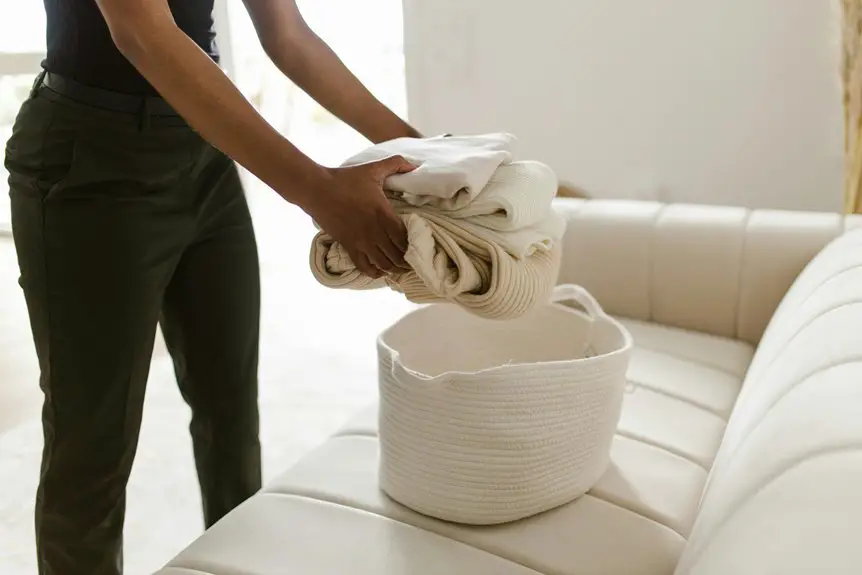To deep clean and deodorize your fabric sofa, start by identifying the fabric type and gathering suitable cleaning supplies like a vacuum, fabric-safe cleaner, and soft cloths. Remove cushions and vacuum the entire sofa, paying special attention to seams. Spot clean stains right away, then deep clean with a mild detergent solution. For deodorizing, sprinkle baking soda, let it sit, then vacuum it up. Follow these steps for a refreshed sofa, and discover more tips for long-lasting care.
Table of Contents
Key Takeaways
- Start by vacuuming the sofa thoroughly, focusing on seams and crevices to remove loose dirt and debris.
- Spot clean any stains immediately with a fabric-safe cleaner, blotting with a clean cloth.
- For deep cleaning, use a mild detergent solution and gently scrub the fabric, testing on a hidden area first.
- Deodorize the sofa by sprinkling baking soda, using a vinegar solution, or applying essential oils for a fresh scent.
- Maintain your sofa by vacuuming weekly and performing regular spot cleaning to prevent the buildup of dirt and odors.
Assessing Your Sofa’s Fabric Type
How can you tell what type of fabric your sofa is made from? Start by checking the care tag, usually located under the cushions. This tag often indicates the fabric type, whether it’s cotton, polyester, or a blend.
If you can’t find the tag, run your fingers over the fabric. Natural fibers like cotton and linen feel soft, while synthetic materials like polyester tend to be smoother and more durable.
You can also do a quick burn test: small fabric samples can help identify the type based on how they burn and smell.
Gathering Your Cleaning Supplies
Once you know your sofa’s fabric type, it’s time to gather your cleaning supplies.
Identify your sofa’s fabric type before collecting your cleaning supplies for a successful cleaning session.
Start with a vacuum cleaner equipped with an upholstery attachment to remove dust and debris. Next, grab a soft brush or microfiber cloth for gentle scrubbing. You’ll also need a fabric-safe cleaner; check the label to verify it’s suited for your sofa.
If you prefer homemade solutions, mix equal parts white vinegar and water in a spray bottle for a natural cleaner. Don’t forget baking soda for deodorizing—sprinkle it on your sofa and let it sit for a while.
Finally, keep a few clean towels handy to absorb moisture and wipe away any excess cleaner. With these supplies, you’re ready to tackle your cleaning project!
Preparing the Sofa for Cleaning
Before diving into the cleaning process, take a moment to prepare your sofa. Start by removing any items on or around it, like cushions, throws, or personal belongings. This clears the way for a thorough clean. Next, inspect the fabric for any stains or damage, noting these spots for special attention later. You’ll also want to check the care label for specific cleaning instructions. Finally, make certain your cleaning area is well-ventilated. Here’s a quick checklist to follow:
| Task | Action |
|---|---|
| Clear the area | Remove cushions and items |
| Inspect the fabric | Look for stains or damage |
| Check cleaning instructions | Review the care label |
| Ensure ventilation | Open windows or use a fan |
Vacuuming the Sofa Thoroughly
To guarantee your deep cleaning is effective, start by vacuuming the sofa thoroughly. Use a vacuum with an upholstery attachment to reach every nook and cranny. Focus on seams, crevices, and under cushions where dirt and debris often hide.
Move the cushions around to verify you’re cleaning all surfaces, not just the visible areas. If your sofa has removable covers, take those off and give them a quick vacuum as well. For stubborn pet hair, consider using a lint roller or a damp sponge.
This step not only removes dust and allergens but also prepares your sofa for the next cleaning stages. Once you’ve vacuumed, you’ll notice a significant difference, making the deep cleaning process much more effective.
Spot Cleaning Stains
Spot cleaning stains is essential for maintaining the appearance of your fabric sofa, especially if you want to prevent permanent damage.
To tackle stains effectively, follow these steps:
- Act Quickly: As soon as you notice a stain, grab a clean cloth and blot the area gently to absorb excess liquid.
- Choose a Cleaner: Use a fabric-safe cleaner or a mixture of mild soap and water. Test it on a hidden area first to verify it won’t discolor the fabric.
- Blot, Don’t Rub: Apply the cleaner to a cloth and gently blot the stain. Rubbing can spread the stain or damage the fabric.
- Rinse and Dry: Wipe the area with a damp cloth to remove any cleaner residue, then let it air dry completely.
Deep Cleaning the Fabric
Deep cleaning your fabric sofa can breathe new life into it and remove built-up dirt and allergens.
Start by vacuuming the entire surface, using an upholstery attachment to reach crevices and seams.
Next, check the care tag to determine the appropriate cleaning solution. If it’s safe, mix a mild detergent with warm water.
Dampen a clean cloth with the solution, then gently scrub the fabric in circular motions, focusing on high-traffic areas.
Rinse another cloth in plain water and wipe away any soap residue. Allow the sofa to air dry completely before using it again.
For stubborn stains, repeat the process or consider a steam cleaner, ensuring you follow the manufacturer’s instructions for best results.
Deodorizing Techniques
Keeping your fabric sofa smelling fresh can be as simple as using a few effective deodorizing techniques. Here are four methods to try:
- Baking Soda: Sprinkle baking soda generously over the sofa and let it sit for at least 15 minutes before vacuuming it up. This absorbs odors effectively.
- Essential Oils: Mix a few drops of your favorite essential oil with water in a spray bottle. Lightly mist your sofa to add a pleasant scent.
- Vinegar Solution: Combine equal parts of water and white vinegar in a spray bottle. Lightly mist your fabric to neutralize odors; the vinegar smell will dissipate quickly.
- Activated Charcoal: Place bowls of activated charcoal around your sofa to absorb unwanted odors over time.
These techniques will help keep your sofa smelling delightful!
Drying and Fluffing the Sofa
Once you’ve cleaned your fabric sofa, it’s essential to guarantee it dries properly to maintain its appearance and comfort.
Start by removing any excess moisture using a clean, dry towel—press it firmly against the fabric to absorb water.
Next, let your sofa air dry completely, which may take several hours. If possible, open windows or turn on fans to improve air circulation and speed up the drying process.
Once it’s dry, gently fluff the cushions and fabric with your hands or a soft brush to restore their original texture. This helps prevent any stiffness or flattening.
Avoid sitting on the sofa until it’s fully dry to maintain its shape and comfort. Your efforts will keep your sofa looking fresh and inviting!
Maintaining Your Clean Sofa
After ensuring your fabric sofa is completely dry and fluffed, it’s time to focus on maintaining its cleanliness and appearance.
Regular upkeep will keep your sofa looking fresh and inviting. Here are a few tips to help you out:
- Vacuum Weekly: Use a handheld vacuum or upholstery attachment to remove dust and crumbs.
- Spot Clean Immediately: Address spills as soon as they happen to prevent stains from setting.
- Rotate Cushions: Flip and rotate cushions regularly to promote even wear and tear.
- Use Fabric Protector: Consider applying a fabric protector to enhance stain resistance and durability.
Frequently Asked Questions
Can I Use Bleach on My Fabric Sofa?
You shouldn’t use bleach on your fabric sofa. It can cause discoloration and damage the fibers. Instead, opt for gentle cleaners designed for upholstery to keep your sofa looking fresh and vibrant.
How Often Should I Deep Clean My Sofa?
You should deep clean your sofa every six to twelve months, depending on usage. If you have pets or kids, consider doing it more frequently. Regular maintenance keeps it looking fresh and extends its lifespan.
What if My Sofa Has Pet Odors?
“Where there’s smoke, there’s fire.” If your sofa’s got pet odors, start by vacuuming thoroughly. Next, use a fabric-safe cleaner or baking soda to eliminate smells, letting it sit before vacuuming again for freshness.
Are Commercial Cleaners Safer Than Homemade Solutions?
Commercial cleaners often contain chemicals that can be harsh, while homemade solutions usually use natural ingredients. You’ll find homemade options safer for your health and environment, but always test any cleaner first to verify compatibility.
Can Steam Cleaning Damage My Sofa Fabric?
Steam cleaning can damage your sofa fabric if it’s too delicate or not designed for high heat. Always check the manufacturer’s guidelines before using steam, and test a small area to verify it won’t cause harm.
- Does Chiffon Fabric Stink - July 15, 2025
- Does Chiffon Fabric Affect the Economy - July 15, 2025
- Does Cotton Fabric Have a Nap - July 15, 2025







